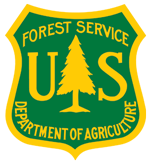-
 Carbon sequestration in the U.S. forest sector from 1990 to 2010
Carbon sequestration in the U.S. forest sector from 1990 to 2010
-
From 1990 through 2005, the forest sector (including forests and wood products) sequestered an average 162 Tg C year1 . In 2005, 49% of the total forest sector sequestration was in live and dead trees, 27% was
in wood products in landfills, with the remainder in down dead wood, wood products in use, and forest floor and soil. The pools with the largest carbon stocks were not the same as those with the largest sequestration rates, except for the tree pool. For example, landfilled wood products comprise only 3% of total stocks but account for 27% of carbon sequestration. Conversely, forest soils comprise 48% of total stocks but account for only 2% of carbon sequestration. For the tree pool, the spatial pattern of carbon stocks was dissimilar to that of carbon flux. On an area basis, tree carbon stocks were highest in the Pacific Northwest, while changes were generally greatest in the upper Midwest and the Northeast. Net carbon sequestration in the forest sector in 2005 offset 10% of U.S. CO2 emissions. In the near future, we project that U.S. forests will continue to sequester carbon at a rate similar to that in recent years. Based on a comparison of our estimates to a compilation of land-based estimates of non-forest carbon sinks from the literature, we estimate that the conterminous U.S. annually sequesters 149–330 Tg C year1. Forests, urban trees, and wood products are responsible for 65–91% of this sink.
Located in
Resources
/
Climate Science Documents
-
 Changes in Avian and Plant Communities of Aspen Woodlands over 12 Years after Livestock Removal in the Northwestern Great Basin
Changes in Avian and Plant Communities of Aspen Woodlands over 12 Years after Livestock Removal in the Northwestern Great Basin
-
Riparian and quaking aspen (Populus tremuloides) woodlands are centers of avian abundance and diversity in the western United States, but they have been affected adversely by land use practices, particularly livestock grazing. In 1990, cattle were removed from a 112,500-ha national wildlife refuge in southeastern Oregon. Thereafter, we monitored changes in vegetation and bird abundance in years 1–3 (phase 1) and 10–12 (phase 2) in 17 riparian and 9 snow-pocket aspen plots. On each 1.5-ha plot, we sampled vegetation in 6 transects. Three times during each breeding season, observers recorded all birds 50 m to each side of the plot’s 150-m centerline for 25 minutes. We analyzed data with multivariate analysis of variance and paired t tests with p values adjusted for multiple comparisons. In both periods, riparian and snow-pocket aspen produced extensive regeneration of new shoots ( x ̄ = 2646 stems/ha and 7079 stems/ha, respectively). By phase 2, a 64% increase in medium-diameter trees in riparian stands indicated successful recruitment into the overstory, but this pattern was not seen in snow-pocket stands, where the density of trees was over 2 times greater. By phase 2 in riparian and snow-pocket stands, native forb cover had increased by 68% and 57%, respectively, mesic shrub cover had increased by 29% and 58%, and sagebrush cover had decreased by 24% and 31%. Total avian abundance increased by 33% and 39% in riparian and snow-pocket aspen, respectively, ground or understory nesters increased by 133% and 67% and overstory nesters increased by 34% and 33%. Similarly, ground or understory foragers increased by 25% and 32%, aerial foragers by 55% and 57%, and overstory foragers by 66% and 43%. We interpreted the substantial regeneration of aspen shoots, increased densities of riparian forbs and shrubs, and increased avian abundances as a multitrophic-level response to the total removal of livestock and as substantial movement toward recovery of biological integrity.
Located in
Resources
/
Climate Science Documents
-
 Changes in climate and land use have a larger direct impact than rising CO2 on global river runoff trends
Changes in climate and land use have a larger direct impact than rising CO2 on global river runoff trends
-
The significant worldwide increase in observed river runoff has been tentatively attributed to the stomatal ‘‘antitranspirant’’ response of plants to rising atmospheric CO2 [Gedney N, Cox PM, Betts RA, Boucher O, Huntingford C, Stott PA (2006) Nature 439: 835– 838]. However, CO2 also is a plant fertilizer. When allowing for the increase in foliage area that results from increasing atmospheric CO2 levels in a global vegetation model, we find a decrease in global runoff from 1901 to 1999. This finding highlights the importance of vegetation structure feedback on the water balance of the land surface. Therefore, the elevated atmospheric CO2 concentration does not explain the estimated increase in global runoff over the last century. In contrast, we find that changes in mean climate, as well as its variability, do contribute to the global runoff increase. Using historic land-use data, we show that land-use change plays an additional important role in controlling regional runoff values, particularly in the tropics. Land-use change has been strongest in tropical regions, and its contribution is substantially larger than that of climate change. On average, land-use change has increased global runoff by 0.08 mm/year2 and accounts for 50% of the reconstructed global runoff trend over the last century. Therefore, we emphasize the importance of land-cover change in forecasting future freshwater availability and climate.
Located in
Resources
/
Climate Science Documents
-
 Changes in the Asian monsoon climate during 1700 –1850 induced by preindustrial cultivation
Changes in the Asian monsoon climate during 1700 –1850 induced by preindustrial cultivation
-
Preindustrial changes in the Asian summer monsoon climate from the 1700s to the 1850s were estimated with an atmospheric general circulation model (AGCM) using historical global land cover/use change data reconstructed for the last 300 years. Extended cultivation resulted in a decrease in monsoon rainfall over the Indian subcontinent and southeastern China and an associated weakening of the Asian summer monsoon circulation. The precipitation decrease in India was marked and was consistent with the observational changes derived from examining the Himalayan ice cores for the concurrent period. Between the 1700s and the 1850s, the anthropogenic increases in greenhouse gases and aerosols were still minor; also, no long-term trends in natural climate variations, such as those caused by the ocean, solar activity, or volcanoes, were reported. Thus, we propose that the land cover/ use change was the major source of disturbances to the climate during that period. This report will set forward quantitative ex-amination of the actual impacts of land cover/use changes on Asian monsoons, relative to the impact of greenhouse gases and aerosols, viewed in the context of global warming on the interannual, decadal, and centennial time scales.
atmospheric water balance climate change historical land-cover change monsoon rainfall
Located in
Resources
/
Climate Science Documents
-
 Characterizing coal and mineral mines as a regional source of stress to stream fish assemblages
Characterizing coal and mineral mines as a regional source of stress to stream fish assemblages
-
Mining impacts on stream systems have historically been studied over small spatial scales, yet investigations over large areas may be useful for characterizing mining as a regional source of stress to stream fishes. The associations between co-occurring stream fish assemblages and densities of various “classes” of mining occurring in the same catchments were tested using threshold analysis. Threshold analysis identifies the point at which fish assemblages change substantially from best available habitat conditions with increasing disturbance. As this occurred over large regions, species comprising fish assemblages were represented by various functional traits as well as other measures of interest to management (characterizing reproductive ecology and life history, habitat preferences, trophic ecology, assemblage diversity and evenness, tolerance to anthropogenic disturbance and state-recognized game species). We used two threshold detection methods: change-point analysis with indicator analysis and piecewise linear regression. We accepted only those thresholds that were highly statistically significant (p 0.01) for both techniques and overlapped within 5% error. We found consistent, wedge-shaped declines in multiple fish metrics with increasing levels of mining in catchments, suggesting mines are a regional source of disturbance. Threshold responses were consistent across the three ecoregions occurring at low mine densities. For 47.2% of the significant thresholds, a density of only 0.01 mines/km2 caused a threshold response. In fact, at least 25% of streams in each of our three study ecoregions have mine densities in their catchments with the potential to affect fish assemblages. Compared to other anthropogenic impacts assessed over large areas (agriculture, impervious surface or urban land use), mining had a more pronounced and consistent impact on fish assemblages. Threshold analysis Fish functional traits Landscape influences Game fishes Mining Rivers
Located in
Resources
/
Climate Science Documents
-
 Citizen Involvement in the U.S. Endangered Species Act
Citizen Involvement in the U.S. Endangered Species Act
-
Data on listed species refute critiques of citizen involvement in the U.S. Endangered Species Act.
Located in
Resources
/
Climate Science Documents
-
 Climate change and the ecologist
Climate change and the ecologist
-
The evidence for rapid climate change now seems overwhelming. Global temperatures are predicted to rise by up to 4 °C by 2100, with associated alterations in precipitation patterns. Assessing the consequences for biodiversity, and how they might be mitigated, is a Grand Challenge in ecology.
Located in
Resources
/
Climate Science Documents
-
 Climate change and tropical biodiversity: a new focus
Climate change and tropical biodiversity: a new focus
-
Considerable efforts are focused on the consequences of climate change for tropical rainforests. However, potentially the greatest threats to tropical biodiversity (synergistic interactions between climatic changes and human land use) remain understudied. Key concerns are that aridification could increase the accessibility of previously non-arable or remote lands, elevate fire impacts and exacerbate ecological effects of habitat disturbance. The growing climatic change literature often fails to appreciate that, in coming decades, climate–land use interac- tions might be at least as important as abiotic changes per se for the fate of tropical biodiversity. In this review, we argue that protected area expansion along key ecological gradients, regulation of human-lit fires, strategic forest–carbon financing and re-evaluations of agricultural and biofuel subsidies could ameliorate some of these synergistic threats.
Located in
Resources
/
Climate Science Documents
-
 Climatic Impact of Tropical Lowland Deforestation on Nearby Montane Cloud Forests
Climatic Impact of Tropical Lowland Deforestation on Nearby Montane Cloud Forests
-
Tropical montane cloud forests (TMCFs) depend on predictable, frequent, and prolonged immersion in cloud. Clearing upwind lowland forest alters surface energy budgets in ways that influence dry season cloud fields and thus the TMCF environment. Landsat and Geostationary Operational Environmental Satellite imagery show that deforested areas of Costa Rica’s Caribbean lowlands remain relatively cloud-free when forested regions have well-developed dry season cumulus cloud fields. Further, regional atmospheric simulations show that cloud base heights are higher over pasture than over tropical forest areas under reasonable dry season conditions. These results suggest that land use in tropical lowlands has serious impacts on ecosystems in adjacent mountains.
Located in
Resources
/
Climate Science Documents
-
 CO2 emissions from land-use change affected more by nitrogen cycle, than by the choice of land-cover data
CO2 emissions from land-use change affected more by nitrogen cycle, than by the choice of land-cover data
-
The high uncertainty in land-based CO2 fluxes estimates is thought to be mainly due to uncertainty in not only quantifying historical changes among forests, croplands, and grassland, but also due to different processes included in calculation methods. Inclusion of a nitrogen (N) cycle in models is fairly recent and strongly affects carbon (C) fluxes. In this study, for the first time, we use a model with C and N dynamics with three distinct historical reconstructions of land-use and land-use change (LULUC) to quantify LULUC emissions and uncertainty that includes the integrated effects of not only climate and CO2 but also N. The modeled global average emissions including N dynamics for the 1980s, 1990s, and 2000–2005 were 1.8 ` 0.2, 1.7 ` 0.2, and 1.4 ` 0.2 GtC yr␣1, respectively, (mean and range across LULUC data sets). The emissions from tropics were 0.8 ` 0.2, 0.8 ` 0.2, and 0.7 ` 0.3 GtC yr␣1, and the non tropics were 1.1 ` 0.5, 0.9 ` 0.2, and 0.7 ` 0.1 GtC yr␣1. Compared to previous studies that did not include N dynamics, modeled net LULUC emissions were higher, particularly in the non tropics. In the model, N limitation reduces regrowth rates of vegetation in temperate areas resulting in higher net emissions. Our results indicate that exclusion of N dynamics leads to an underestimation of LULUC emissions by around 70% in the non tropics, 10% in the tropics, and 40% globally in the 1990s. The differences due to inclusion/exclusion of the N cycle of 0.1 GtC yr␣1 in the tro- pics, 0.6 GtC yr␣1 in the non tropics, and 0.7 GtC yr␣1 globally (mean across land-cover data sets) in the 1990s were greater than differences due to the land-cover data in the non tropics and globally (0.2 GtC yr␣1). While land-cover information is improving with satellite and inventory data, this study indicates the importance of accounting for different processes, in particular the N cycle.
Keywords: carbon cycle, carbon emissions, land-use change, model, nitrogen cycle
Located in
Resources
/
Climate Science Documents























